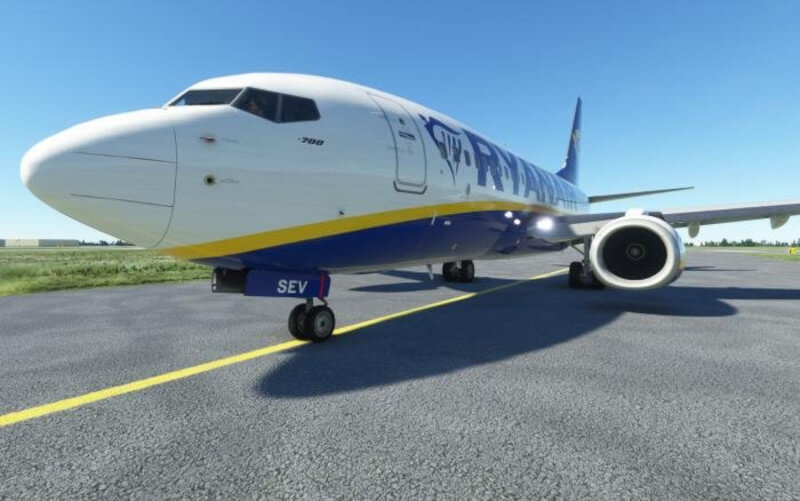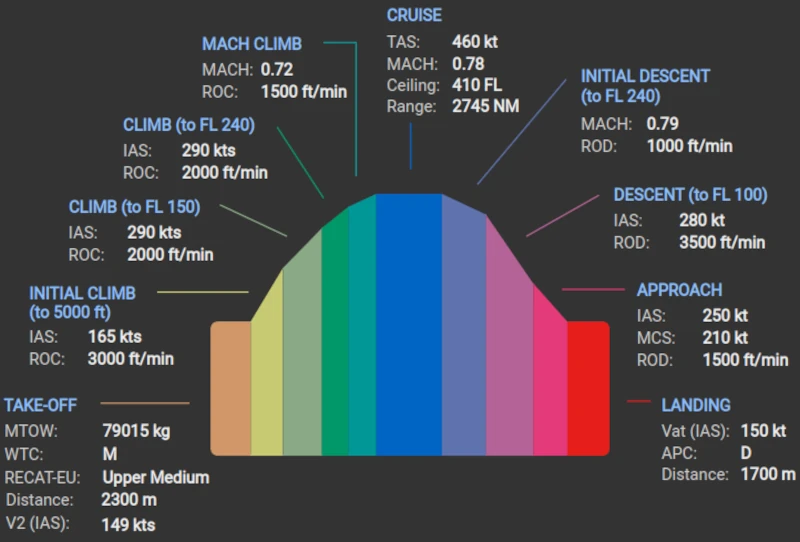
About Boeing 737 700
Boeing 737-700, representing one of the early modifications of the Next Generation family, is a narrow-body aircraft equipped with two turbofan engines. This aircraft replaced the outdated 737-300, becoming the first model developed within the framework of the updated 737 Next Generation family.
Comparing it to its predecessor, the Boeing 737-700 stands out with the use of dual-flow CFM International CFM56-7B20s engines, providing a thrust of 91.6 kN, enhancing its performance and efficiency. Additionally, the model has been updated with modern tail surfaces and wings, contributing to improved aerodynamic characteristics.
In terms of passenger capacity, the Boeing 737 700 maintains similarity to its predecessor. In a two-class cabin layout, it accommodates 126 passengers, and with the maximum seating configuration, this airliner can board up to 149 passengers. This ensures flexibility for airlines in managing passenger flows and adapting to various market conditions.
It’s worth noting that the Boeing 737-700 embodies innovative solutions in the aviation industry, aiming to combine high performance, fuel efficiency, and passenger comfort. This aircraft continues to uphold the finest traditions of the 737 family, making a significant contribution to the development of global aviation.
Modern interior
When decorating the cabin of the Boeing 737-700, new design solutions are used, which distinguish the new series from earlier modifications. In particular, the luggage compartment lids received a rounded shape, and the ceiling lines became smooth. LED illumination gives a bright but comfortable glow for the eyes.
Advantages of Boeing 737 700
The airplane is considered one of the most comfortable and economical for corporate flights. Large passenger cabin capacity. Turbojet engines with reduced fuel consumption reduce the cost of the flight. The aircraft is used for seasonal charter flights and one-off transportation.

History
The development of the Boeing 737-700 marked a significant milestone in aviation history, officially announced in November 1993. Southwest Airlines, pioneering this new era, placed a groundbreaking pre-order for 63 aircraft in January 1994. Initially known as the Boeing 737-300X, the aircraft showcased its evolutionary connection with the established Boeing 737-300 model.
A noteworthy upgrade included the incorporation of CFM International CFM56-7B20s turbofan engines, delivering a formidable thrust of approximately 91.6 kN. The Boeing 737-700 underwent transformative enhancements, featuring a redesigned tail assembly and wings with an expanded wingspan of 5.44 meters compared to its predecessor, the Boeing 737-300.
Revolutionizing the cockpit experience, the Boeing 737-700 introduced cutting-edge digital avionics EFIS by Honeywell, featuring a suite of six multifunctional LCD displays. The integration of a Head-Up Display (HUD) or ILS elevated the aircraft’s navigational capabilities to new heights.
Drawing inspiration from the acclaimed Boeing 757, the passenger cabin of the Boeing 737-700 was meticulously crafted to provide an unparalleled level of comfort. While retaining certain elements from the Boeing 737-300, this new model underwent substantial refinements across various facets.
On December 7, 1996, the inaugural Boeing 737-700 emerged from the production hangar, symbolizing the dawn of a groundbreaking era in aviation. The aircraft took its maiden flight on February 9, 1997, and by November of the same year, following meticulous testing and certification, the Boeing 737-700 commenced operational service, setting the stage for a legacy defined by exceptional performance and technological prowess.
Boeing 737-700 Technical Specifications

Dimensions
| Length (M) | 33.60 |
| Height (M) | 12.60 |
| Wingspan (M) | 34.32 |
| Wing Area (sq.m) | 124.58 |
| Fuselage Width (m) | 3.76 |
| Cabin Width (m) | 3.53 |
Performance Data
| Flight Range (km) | 8150 |
| Cruising Speed (KM/H) | 936 |
| Max Speed (KM/H) | 978 |
| Takeoff Length (M) | 2042 |
| Landing Length (M) | 1415 |
| Engines | 2 × CFM International CFM56-7B20 |
| Engine Thrust (kN) | 2 × 89 |
| Max Fuel Capacity (L) | 26035 |
| Max Altitude (M) | 12500 |
Passenger Cabin
| Crew | 2 pilots |
| Number of Passengers | 149 |
Weight
| Empty Operating Weight (kg) | 37585 |
| Max Takeoff Weight (kg) | 77564 |
| Max Landing Weight (kg) | 60781 |
Modifications of Boeing 737-700
From its basic concept, the Boeing 737-700 has become a remarkable platform for various modifications, giving airlines and air forces the opportunity to customize this airliner to meet a variety of needs. One of the unique modifications is the Boeing 737-700ER (Extended Range), which impresses with its extended range. Launched in January 2006, it immediately gained the attention of All Nippon Airways, becoming its first customer.
With this modification, the Boeing 737-700ER became not just an airplane, but a true long-haul aircraft designed for long flights. Using the fuselage of the base model 737-700 and wings with landing gear from the 737-800, this airliner is designed to carry 126 passengers over an impressive distance of 10,200 km. This modification has become competitive with the Airbus A319LR and is the second longest range in the 737 family after the BBJ2.
The Boeing 737 BBJ (Boeing Business Jet) is another innovative modification, transforming the basic 737-700 into a luxury business jet. Designed to offer special comfort, this business jet can accommodate 25 to 50 passengers. Inside it can be found bedrooms, bathrooms, conference rooms and lounges, creating a unique space for business meetings and relaxation.
The C-40 Clipper, based on the Boeing 737-700C, is a specialized airliner ordered by the U.S. Air Force to replace the McDonnell Douglas C-9B Skytrain II. The use of the C-40B and C-40C in transporting top commanders underscores its role in strategic mobility.
The Boeing 737 AEW&C is a unique modification that transforms the Boeing 737-700 into an early warning and battle management (EW&C) aircraft. Initiated in response to an order from the Royal Australian Air Force, the airliner, also known as the E-7A Wedgetail, has been successfully delivered not only to Australia but also to other countries including Turkey and the Republic of Korea.
The Boeing 737-700C, being the freighter version, is equipped with a side hatch and is capable of carrying significant cargo loads, making it an indispensable military transport, including for the US Navy (C40A).
The Boeing 737-700QC, featuring the Quick Change modification, is notable for its adaptability. With its distinctive cabin layout, the seats are affixed to pallets, enabling swift transformation between a passenger configuration and a cargo configuration, and vice versa. This results in a reduction of the conversion time from 5 hours to a mere 1 hour.
As for the Boeing 737-700F, it represents a cargo variant derived from the original passenger model, offering streamlined and effective cargo transportation.
The Boeing 737-700BDSF (Bedek Special Freighter), crafted by IAI Bedek in Tel Aviv, is yet another cargo adaptation that transforms a regular passenger airplane into an exceptionally efficient freighter.
Boeing 737-700 Seat Map
The Boeing 737-700 airplane layout includes 126 to 149 seats. Boeing 737-700 airplanes offer two classes of service — business class and economy class. Seating arrangement can vary depending on the airline and their preferences.
The main features of the new subfamily are: new passenger cabin interior, improved cockpit layout and improved avionics. The cabin is equipped with more comfortable seats. Compared to the models of the previous series, the volume of overhead shelves for passengers’ belongings has been increased.
Business Class
Business Class is usually located at the front of the cabin, while Economy Class is located in the rest of the airplane.
In general terms, business class usually has more legroom and comfortable Boeing 737-700 seating that can convert to fully horizontal beds. A 2×2 layout provides comfortable seating.
Business class passengers are usually offered a variety of dining options, including specially selected menus consisting of gourmet meals. The business class restroom is located at the front of the aircraft. There are also separate compartments with kitchen equipment.
Economy Class
In economy class, there is usually less legroom between seats and the seats can be arranged in a 3-4-3 or 3-3 arrangement. In economy class, meals are usually offered in the form of pre-packaged lunch boxes or trays.
Row 10 is the first row of seats behind the business class, from which it is separated by a partition. There are no passengers in front, so no one will tilt the backrest and create discomfort. The peculiarity of the seats is the presence of fasteners for cradles for children.
Row 11-16 are standard seats. All Boeing 737 700 seating are located at the same distance according to the scheme 3×3.
Row 17 — seats in front of emergency exits. Backs are rigidly fixed, the angle of inclination does not change.
Row 18 — seats on the Boeing 737-700 seat map behind the emergency exit. There are no seats in front, so the reclined backrests do not interfere with the flight, and the legroom is also increased. Only adult citizens traveling without animals can occupy seats in the 18th row. The seats do not seat elderly people and people with disabilities.
Row 30 — the last seats in the cabin, located in front of the toilet. The seat back does not recline.
For the economy class cabin there are two toilets in the tail of the Boeing 737-700. There is a kitchen behind the wall.
Comparison of B777-200 Seat Maps
| Airline | Cabin / Configuration | Seats |
|---|---|---|
| Boeing 737-700 Germania | Economy / 3-3 | 148 |
| Boeing 737-700 United | Business / 2-2 Economy / 3-3 |
126 |
| Boeing 737-700 Turkish Airlines | Economy / 3-3 | 124 |
| Boeing 737-700 SunExpress | Economy / 3-3 | 149 |
| Boeing 737-700 Southwest Airlines | Economy / 3-3 | 143 |
| Alaska Airlines Boeing 737-700 | First 2-2 Economy / 3-3 |
124 |
| Air Transat Boeing 737-700 | Economy / 3-3-3 | 144 |
| Kenya Airways Boeing 737-700 | Business / 2-2 Economy / 3-3 |
116 |
| WestJet Boeing 737-700 | Economy / 3-3 | 130 |
| China Eastern Airlines Boeing 737-700 | Business / 2-2 Economy / 3-3 |
128, 134 |
| Delta Air Lines Boeing 737-700 | First / 2-2 Economy / 3-3 |
124 |
| Ethiopian Airlines Boeing 737-700 | Business / 2-2 Economy / 3-3 |
118 |
| Fiji Airways Boeing 737-700 | Business / 2-2 Economy / 3-3 |
122 |
| KLM Boeing 737-700 | Business / 2-2 Economy / 3-3 |
132 |
| China Southern Airlines Boeing 737-700 | Business / 2-2 Economy / 3-3 |
134 |
| Virgin Australia Boeing 737-700 | Business / 2-2 Economy / 3-3 |
128 |
| Scandinavian Airlines (SAS) Boeing 737-700 | Economy / 3-3 | 141 |
| Air China Boeing 737-700 | First / 2-2 Economy / 3-3 |
128 |
| Copa Airlines Boeing 737-700 | Business / 2-2 Economy / 3-3 |
124, 126 |


